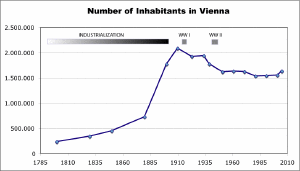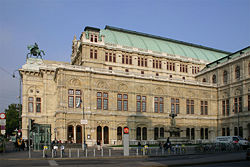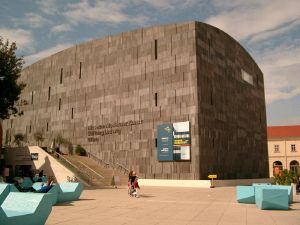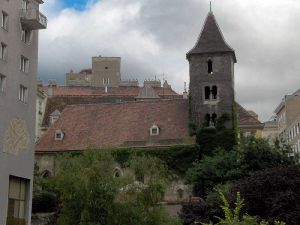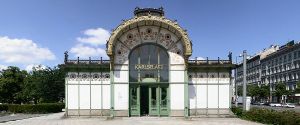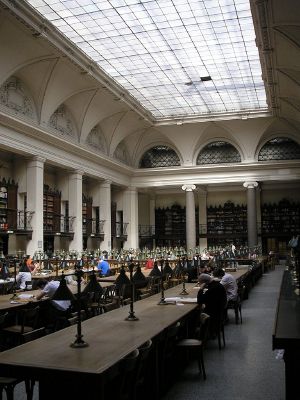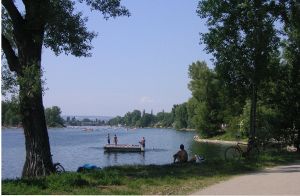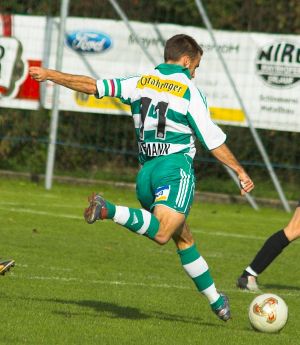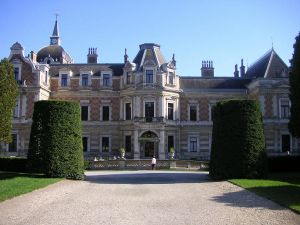Difference between revisions of "Vienna, Austria" - New World Encyclopedia
(Wanted) |
Keisuke Noda (talk | contribs) |
||
| Line 1: | Line 1: | ||
| + | {{claimed}} | ||
| + | {{otheruses}} | ||
| + | {{redirect|Wien}} | ||
| + | {{refimprove|date=June 2007}} | ||
| + | {{coor title dms|48|12|31|N|16|22|19|E|type:city(1651437)}} | ||
| + | {| class="infobox" style="font-size: 90%" | ||
| + | |- | ||
| + | ! colspan="2" style="background:#EFEFEF"|State Coat of Arms | ||
| + | |- | ||
| + | | colspan="2" align="center" | [[Image:Wien 3 Wappen.svg|150px|[[Coat of Arms]] of the city/state of Vienna]] | ||
| + | |- | ||
| + | ! colspan="2" style="background:#EFEFEF"|General Information | ||
| + | |- | ||
| + | | Country: | ||
| + | | [[Austria]] | ||
| + | |- | ||
| + | | State Capital: | ||
| + | | Vienna | ||
| + | |- | ||
| + | | [[ISO 3166-2:AT|ISO 3166-2]]: | ||
| + | | AT-9 | ||
| + | |- | ||
| + | | [[License plate|Vehicle Registration]]: | ||
| + | | W | ||
| + | |- | ||
| + | | [[Community Identification Number]]: | ||
| + | | 90101 - 92301 | ||
| + | |- | ||
| + | | [[Postal code]]s: | ||
| + | | 1010 - 1239, 1400, 1450 | ||
| + | |- | ||
| + | | [[Area code]]: | ||
| + | | 01 | ||
| + | |- | ||
| + | | Homepage: | ||
| + | | [http://www.wien.gv.at/ www.wien.gv.at] | ||
| + | |- | ||
| + | ! colspan="2" style="background:#EFEFEF"|State Flag of Vienna | ||
| + | |- | ||
| + | | colspan="2" align="center" | [[Image:Flag of Wien (state).svg|200px|State [[Flag]] of the city/state of Vienna]] | ||
| + | |- | ||
| + | ! colspan="2" style="background:#EFEFEF"|Map: Vienna in Austria | ||
| + | |- | ||
| + | | colspan="2" align="center" | [[Image:Austria wien.svg|200px|Map of Austria (Vienna)]] | ||
| + | |- | ||
| + | ! colspan="2" style="background:#EFEFEF"|Name in other languages | ||
| + | |- | ||
| + | | [[German language|German]] | ||
| + | | Wien | ||
| + | |- | ||
| + | ! colspan="2" |See [[Names of European cities in different languages: U-Z#V|"Vienna" in other languages]] | ||
| + | |- | ||
| + | ! colspan="2" style="background:#EFEFEF"|Politics | ||
| + | |- | ||
| + | | [[List of mayors of Vienna|Mayor]] and [[governor]] | ||
| + | | [[Michael Häupl]] ([[SPÖ]]) | ||
| + | |- | ||
| + | | Governing Party | ||
| + | | [[SPÖ]] | ||
| + | |- valign="top" | ||
| + | | [[Distribution of seats in the Austrian Landtagen|Seats in the Municipal Council]]<br>(100 seats): | ||
| + | | [[SPÖ]] 55<br>[[ÖVP]] 18<br>[[Austrian Green Party|Greens]] 14<br>[[FPÖ]] 13 | ||
| + | |- valign="top" | ||
| + | | Last Election: | ||
| + | | [[23 October]] [[2005]] | ||
| + | |- valign="top" | ||
| + | | Next Election: | ||
| + | | October [[2010]] | ||
| + | |- | ||
| + | ! colspan="2" style="background:#EFEFEF"|Population | ||
| + | |- | ||
| + | | valign="top" | [[Population]]: | ||
| + | | 1,660,534 <small>''(31.12.2005)''<ref name="population">{{cite web |url=http://www.wien.gv.at/statistik/daten/pdf/bev-uebersicht.pdf |format=[[Portable Document Format|PDF]] |title=Übersicht Bevölkerungsstatistik |language=German |publisher=City of Vienna}}</ref></small> <br>''2,165,357 metro area'' | ||
| + | |- | ||
| + | | [[Population density]]: | ||
| + | | 4,002.2/km² | ||
| + | |- | ||
| + | ! colspan="2" style="background:#EFEFEF"|Geography | ||
| + | |- | ||
| + | | [[Area]]: | ||
| + | | 414.90 [[Square kilometre|km²]] | ||
| + | |- | ||
| + | | - percent land: | ||
| + | | 395.51 [[Square kilometre|km²]] (95,33%) | ||
| + | |- | ||
| + | | - percent water: | ||
| + | | 19.39 [[Square kilometre|km²]] (4,67%) | ||
| + | |- | ||
| + | | valign="top" | [[Geographic coordinate system|Location]]: | ||
| + | | {{coor dm|48|13|N|16|22|E|type:city(3390444)_region:AT-9}} | ||
| + | |- | ||
| + | | valign="top" | Dimensions: | ||
| + | | North-South: 22.4 km <br>East-West: 29.2 km | ||
| + | |- | ||
| + | | valign="top" | Highest Point: | ||
| + | | 543 m<br>([[Hermannskogel]]) | ||
| + | |- | ||
| + | | valign="top" | Lowest Point: | ||
| + | | 151 m<br>([[Lobau]]) | ||
| + | |- | ||
| + | ! colspan="2" style="background:#EFEFEF"|Administrative Structure | ||
| + | |- | ||
| + | | valign="top" | Districts: | ||
| + | | 1 [[Statutarstadt]]<br>23 [[Bezirk]]e | ||
| + | |- | ||
| + | ! colspan="2" style="background:#EFEFEF"|Map: Districts of Vienna | ||
| + | |- | ||
| + | | colspan="2" align="center" | [[Image:VienneseDistrictsWithNumbers.png|150px|Bezirke of Vienna]] | ||
| + | |} | ||
| + | '''Vienna''' ({{lang-de|Wien}} {{IPA|[ʋiːn]}}, [[Austro-Bavarian]]: ''Weăn'', see also [[Names of European cities in different languages: U-Z#V|other names]]) is the [[capital]] of [[Austria]], and also one of the nine [[States of Austria]]. Vienna is Austria's [[primate city]]; with a population of about 1.7 million (2.2 million within the [[metropolitan area]]), and is by far the largest city in Austria as well as its [[culture of Austria|cultural]], economic and [[Politics of Austria|political]] centre. Vienna lies in the very east of Austria and is close to the [[Czech Republic]], [[Slovakia]] and [[Hungary]]. In 2001, the city centre was designated a [[UNESCO]] [[World Heritage Site]]<ref>{{cite web |url=http://whc.unesco.org/pg.cfm?cid=31&id_site=1033 |title=Historic Centre of Vienna |date= |publisher=[[UNESCO]]}}</ref> and the city ranks third in the world in terms of quality of life.<ref>{{cite web | url=http://news.bbc.co.uk/2/hi/business/4306936.stm | title=Vancouver is 'best place to live' | date=October 4, 2005 | publisher=BBC}}</ref> | ||
| − | {{ | + | ==History== |
| + | [[Image:Wien1858.jpg|thumb|left|Vienna in 1858]] | ||
| + | {{main|History of Vienna}} | ||
| + | |||
| + | Founded around [[500 B.C.E.]], Vienna was originally a Celtic settlement. In [[15 B.C.E.]], Vienna became a [[Roman Empire|Roman]] frontier city ("[[Vindobona]]") guarding the [[Roman Empire]] against Germanic tribes to the north. | ||
| + | |||
| + | During the [[Middle Ages]], Vienna was home of the [[Babenberg]] Dynasty and in [[1440]] became residence city of the [[Habsburg]] dynasties from where Vienna eventually grew to become the secret capital of the [[Holy Roman Empire]] and a cultural centre for arts and science, music and fine cuisine. The [[Ottoman Empire|Ottoman]] invasions of [[Europe]] in the [[16th century|16th]] and [[17th century|17th]] centuries were stopped twice just outside Vienna (see [[Siege of Vienna]], 1529 and [[Battle of Vienna]], 1683). | ||
| + | |||
| + | In [[1805]], Vienna became capital of the [[Austrian Empire]] — and later the [[Austro-Hungarian Empire]] — and played a major role in European and World politics, including hosting the 1815 [[Congress of Vienna]]. Adolf Hitler lived in Vienna from 1907 until 1913. The Academy Of Fine Arts of the city rejected him as a student. When Hitler became broke and homeless he stayed at homeless shelters like the one on the Meldemann Strasse. In [[1918]], after [[World War I]], Vienna became capital of the [[First Austrian Republic]]. In 1938 Hitler spoke to the Austrian people from the balcony of the Neue Burg, a part of the Hofburg at the Heldenplatz. Between 1938 (''[[Anschluss|Anschluß]]'') and the end of the [[World War II|Second World War]], Vienna lost its status as a capital to [[Berlin]]. In [[1945]], the [[Vienna Offensive]] was successfully launched by the Soviets against the Germans holding Vienna. The city was besieged for about two weeks before it fell to the Soviets. After [[1945]], Vienna was again the capital of Austria. It was initially divided into four zones by the [[Allies]]. Vienna became a hot-bed for international [[espionage]] between the Western and Eastern blocs. | ||
| + | |||
| + | ===Historical population=== | ||
| + | Due to [[industrialization]] and immigration from other parts of the Empire, the population of Vienna increased sharply during its time as capital of [[Austria-Hungary]] ([[1867]]-[[1918]]). However, after [[World War I]], many [[Czech people|Czechs]] and [[Hungarian people|Hungarians]] returned to their ancestral countries, resulting in a decline in the Viennese population. At the height of the immigration, about one third of the people living in Vienna were of [[Slavs|Slavic]] or Hungarian descent. | ||
| + | |||
| + | By 2001, only 16% of people living in Vienna had nationalities other than Austrian, nearly half of which were from the former [[Yugoslavia]]; the next most numerous nationalities in Vienna were [[Turkey|Turkish]] (39,000 or 2.5%), [[Poland|Polish]] (13,600 or 0.9%) and [[Germany|German]] (12,700 or 0.8%) <ref name="census">{{cite book |url=ftp://www.statistik.at/pub/neuerscheinungen/vz01wien_web.pdf |format=[[Portable Document Format|PDF]] |publisher=[[Statistik Austria]] |year=2003 |title=Volkszählung. Hauptergebnisse I - Wien |language = German}}</ref>. | ||
| + | [[Image:Vienna-inhabitants.gif|thumb|right|Inhabitants according to official census figures: 1800 to 2005]] | ||
| + | [[Image:Rathaus Wien.jpg|thumb|The [[Rathaus, Vienna|Rathaus]] serves as the seat of the [[List of mayors of Vienna|mayor]] and city council of the city of Vienna]] | ||
| + | [[Image:Wien Stefansdom DSC02656.JPG|thumb|[[St. Stephen's Cathedral, Vienna|Stephansdom]]]] | ||
| + | |||
| + | ==Subdivision== | ||
| + | {{main|Districts of Vienna}} | ||
| + | Vienna is composed of 23 districts (''Bezirke''). Legally, they are not [[district]]s in the sense of administrative bodies with explicit powers (such as the districts in the other Austrian states), but mere subdivisions of the city administration. Elections at the district level give the representatives of the districts some political power in fields such as planning and traffic. | ||
| + | |||
| + | The 23 districts are numbered for convenience in a roughly clockwise fashion starting in the city centre: 1. [[Innere Stadt]], 2. [[Leopoldstadt]], 3. [[Landstraße]], 4. [[Wieden]], 5. [[Margareten]], 6. [[Mariahilf]], 7. [[Neubau]], 8. [[Josefstadt]], 9. [[Alsergrund]], 10. [[Favoriten]], 11. [[Simmering (Vienna)|Simmering]], 12. [[Meidling]], 13.[[Hietzing]], 14. [[Penzing (Vienna)|Penzing]], 15. [[Rudolfsheim-Fünfhaus]], 16. [[Ottakring]], 17. [[Hernals]], 18. [[Währing]], 19. [[Döbling]], 20. [[Brigittenau]], 21. [[Floridsdorf]], 22. [[Donaustadt]], 23. [[Liesing]]. | ||
| + | |||
| + | The heart and historical city of Vienna, the [[Innere Stadt]], was once surrounded by walls and open fields in order to deny cover to potential attackers. The walls were razed in [[1857]], making it possible for the city to expand and eventually merge with the surrounding villages. In their place, a broad boulevard called the [[Ringstraße]] was built, along which imposing public and private buildings, monuments, and parks now lie. These buildings include the [[Rathaus, Vienna|Rathaus]] (town hall), the [[Burgtheater]], the [[University of Vienna|University]], the [[Parliament of Austria|Parliament]], the twin museums of [[Naturhistorisches Museum|natural history]] and [[Kunsthistorisches Museum|fine art]], and the [[Vienna State Opera|Staatsoper]]. It is also the location of the [[Hofburg]], the former imperial palace. The mainly [[gothic architecture|Gothic]] [[Saint Stephen's Cathedral, Vienna|Stephansdom]] is located at the centre of the city, on [[Stephansplatz]]. Beyond the Ringstraße, there was another wall called the [[Linienwall]], which was torn down in the latter half of the [[19th century]] to make room for expanding [[suburb]]s. It is now a [[beltway|ring road]] called [[Gürtel, Vienna|Gürtel]]. | ||
| + | |||
| + | Industries are located mostly in the southern and eastern districts. The [[Innere Stadt]] is situated away from the main flow of the [[Danube]], but is bounded by the ''[[Donaukanal]]'' ("Danube canal"). Vienna's second and twentieth districts are located between the Donaukanal and the [[Danube River]]. Across the Danube are the newest districts, which include the location of the [[Vienna International Centre]]. | ||
| + | |||
| + | Vienna's postal codes can be determined by the district where a given address is located; 1XXA - 1 denotes Vienna, XX the district number (if it is a single digit then with a leading zero), A is the number of the post office (irrelevant in this case, usually zero). Example: 1070 for Neubau. Exceptions include 1300 for the [[Vienna International Airport]] located in [[Lower Austria]] near [[Schwechat]], 1400 for the [[United Nations|UN]] Complex, 1450 for the Austria Center, and 1500 for the Austrian UN forces. | ||
| + | |||
| + | ==Politics== | ||
| + | Until 1918, Viennese politics were shaped by the [[Christian Social Party (Austria)|Christian Social Party]], in particular long-term mayor [[Karl Lueger]]. Vienna is today considered the centre of [[Social Democracy]] in Austria. During the period of the [[First Austrian Republic|First Republic]] (1918-1934), the Vienna Social Democrats undertook many overdue social reforms, improving the quality of life for hundreds of thousands of workers in the city. At that time, Vienna's municipal policy was admired by [[Socialism|Socialists]] throughout Europe, who therefore referred to the city as "[[Red Vienna]]" (''Rotes Wien''). Since the end of the [[World War I|First World War]], the city has been governed by the Social Democratic Party with absolute majorities in the city parliament. Only between 1934 and 1945, when the Social Democratic Party was illegal, mayors were appointed by the [[Austrofascism|austro-fascist]] and later by the [[Nazism|Nazi]] authorities. Current [[mayor]] of Vienna is [[Michael Häupl]]. The Social Democrats currently hold 55% of the seats with a 49% share of the vote<ref>{{cite web |url=http://www.wien.gv.at/wahl/NET/GR051/GR051-109.htm |title=Gemeinderatswahl 2005 |publisher=wien.at}} {{de icon}}</ref>. An example of the city’s many social democratic [[Policy|policies]] is its low-cost residential estates called ''[[Gemeindebau]]ten''. | ||
| + | |||
| + | Ever since Vienna obtained [[federal state]] (''Bundesland'') status of its own in 1921, the mayor has also had the role of the [[state governor]] (''Landeshauptmann''). The Rathaus accommodates the offices of the mayor and the state government (''Landesregierung''). The city is administered by a multitude of [[department]]s (''Magistratsabteilungen''). | ||
| + | |||
| + | ==Religions== | ||
| + | Vienna is the seat of the Viennese [[Roman Catholic]] [[Roman Catholic Archdiocese of Vienna|archdiocese]], and its acting [[Archbishop]] is [[Cardinal (Catholicism)|Cardinal]] [[Christoph Schönborn]]. The religions of the Viennese resident population is divided according to the [[2001]] [[census]] as follows <ref name="census"/>: | ||
| + | {| | ||
| + | |[[Roman Catholic]] | ||
| + | |49.2% | ||
| + | |- | ||
| + | |No religion | ||
| + | |25.7% | ||
| + | |- | ||
| + | |[[Muslim]] | ||
| + | |7.8% | ||
| + | |- | ||
| + | |[[Eastern Orthodox Church|Orthodox]] | ||
| + | |6.0% | ||
| + | |- | ||
| + | |[[Protestant]] (mostly [[Lutheran]]) | ||
| + | |4.7% | ||
| + | |- | ||
| + | |[[Judaism|Jewish]] | ||
| + | |0.5% | ||
| + | |- | ||
| + | |Other or none indicated | ||
| + | |6.3% | ||
| + | |} | ||
| + | <br clear=all> | ||
| + | ==Culture== | ||
| + | {{Infobox World Heritage Site | ||
| + | | WHS = Historic Centre of Vienna | ||
| + | | Image = [[Image:Wien Staatsoper.jpg|250px|right|Vienna State Opera]] | ||
| + | | State Party = {{AUT}} | ||
| + | | Type = Cultural | ||
| + | | Criteria = ii, iv, vi | ||
| + | | ID = 1033 | ||
| + | | Region = [[List of World Heritage Sites in Europe|Europe]] | ||
| + | | Year = 2001 | ||
| + | | Session = 25th | ||
| + | | Link = http://whc.unesco.org/en/list/1033 | ||
| + | }} | ||
| + | [[Image:Museum Moderner Kunst Stiftung Ludwig Wien.jpg|thumb|The ''Museum moderner Kunst'' ("museum of modern art") is a part of the [[Museumsquartier]]]] | ||
| + | [[Image:Ruprechtskirche Wien.jpg|thumb|Vienna's oldest church: the [[Ruprechtskirche]]]] | ||
| + | [[Image:Otto-Wagner-Pavillon 110606.jpg|thumb|The ''[[Jugendstil]]'' [[Karlsplatz Stadtbahn Station]] by [[Otto Wagner]]]] | ||
| + | [[Image:Uni Wien Bibliothek, Vienna 2.jpg|thumb|Library of the University of Vienna]] | ||
| + | ===Music, theatre and opera=== | ||
| + | {{see also|Music of Austria|Vienna State Opera Ballet}} | ||
| + | |||
| + | :''Translated from [[:de:Wien#Theater .26 Oper|here]]'' | ||
| + | Art and culture have a long tradition in Vienna, including [[theatre]], [[opera]], [[European classical music|classical music]] and fine arts. The [[Burgtheater]] is considered one of the best theatres in the German-speaking world alongside its branch, the Akademietheater. The [[Volkstheater Wien]] and the [[Theater in der Josefstadt]] also enjoy good reputations. There is also a multitude of smaller theatres, in many cases devoted to less mainstream forms of performing arts, such as modern, experimental plays or [[cabaret]]. | ||
| + | |||
| + | Vienna is also home to a number of opera houses, including the [[Vienna State Opera|Staatsoper]] and the [[Vienna Volksoper|Volksoper]], the latter being devoted to the typical Viennese [[operetta]]. Classical concerts are performed at well known venues such as the [[Wiener Musikverein]], home of the [[Vienna Philharmonic]] Orchestra, and the [[Wiener Konzerthaus]]. Many concert venues offer concerts aimed at tourists, featuring popular highlights of Viennese music (particularly the works of [[Wolfgang Amadeus Mozart]] and [[Johann Strauss]]). | ||
| + | |||
| + | In recent years, the [[Theater an der Wien]] has become widely known for hosting premieres of [[Musical theater|musicals]], although it has recently devoted itself to the opera again. The most successful musical by far was "Elisabeth", which was later translated into several other languages and performed all over the world. The [[Haus der Musik]] ("house of music") opened in [[2000]]. | ||
| + | |||
| + | Many Roman Catholic churches in central Vienna also feature performances of religious or other music, including masses sung with classical music and organ. | ||
| + | |||
| + | ===Museums=== | ||
| + | : ''To be translated from [[:de:Wien#Museen|here]]'' | ||
| + | The [[Hofburg]] is the location of the Schatzkammer (treasury), holding the imperial jewels of the Hapsburg dynasty. The Sisi Museum (a museum devoted to Empress Elisabeth Amalie Eugenie of Austria) allows visitors to view the Imperial apartments as well as the silver cabinet. Directly opposite the Hofburg are the ''[[Kunsthistorisches Museum]]'' and the Naturhistorisches Museum, which houses many paintings by old masters and ancient and classical artefacts. | ||
| + | |||
| + | A number of museums are located in the [[Museumsquartier]] (museum quarter), the former Imperial Stalls which were converted into a museum complex in the 1990s. It houses the Museum of Modern Art (Ludwig Foundation), the [[Leopold Museum]] (focussing on works of the Viennese Secession, Viennese Modernism and Austrian Expressionism), additional halls with feature exhibitions and the Tanzquartier. The Liechtenstein Palace contains one of the world's largest private art collections. There are a multitude of other museums in Vienna, including the Military History Museum, the [[Technisches Museum Wien|Technical Museum]], the Vienna Clock Museum and the Burial Museum. The museums dedicated to Vienna's districts provide a retrospective of the respective districts. | ||
| + | |||
| + | ===Architecture=== | ||
| + | {{see also|Category:Buildings and structures in Austria}} | ||
| + | |||
| + | : ''Translated from [[:de:Wien#Architektur|here]]'' | ||
| + | A variety of [[architecture|architectural]] styles can be found in Vienna, such as the [[Romanesque architecture|Romanesque]] [[Ruprechtskirche]] and the [[Baroque architecture|Baroque]] [[Karlskirche]]. Styles range from [[classicism|classicist]] buildings to [[modern architecture]]. [[Art Nouveau]] left many architectural traces in Vienna. The [[Vienna Secession|Secession]], [[Karlsplatz Stadtbahn Station]], and the [[Kirche am Steinhof]] by [[Otto Wagner]] rank among the best known examples of Art Nouveau in the world. | ||
| + | |||
| + | The [[Hundertwasserhaus]] by [[Friedensreich Hundertwasser]], designed to counter the clinical look of modern architecture, is one of Vienna's most popular tourist attractions. Another example of unique architecture is the [[Wotruba Church|Wotrubakirche]] by sculptor [[Fritz Wotruba]]. | ||
| + | |||
| + | In the 1990s, a number of quarters were adapted and extensive building projects were implemented in the areas around Donaustadt (north of the Danube) and Wienerberg (in southern Vienna). The 202 [[metre|m]]-high [[Millennium Tower, Vienna|Millennium Tower]] located at Handelskai is the highest building in Vienna{{Fact|date=February 2007}}. In recent years, Vienna has seen numerous architecture projects completed which combine modern architectural elements with old buildings, such as the remodelling and revitalisation of the old [[Gasometer, Vienna|Gasometer]] in 2001. | ||
| + | |||
| + | Most buildings in Vienna are relatively low; there are currently (early 2006) around 100 buildings higher than 40 m. The number of high-rise buildings is kept low by building legislation aimed at preserving green areas and districts designated as [[World Heritage Site|world cultural heritage]]. Strong rules apply to the planning, authorisation and construction of high-rise buildings. Consequently, much of the inner city is a high-rise free zone. | ||
| + | |||
| + | ==Education== | ||
| + | Vienna is also Austria's main centre of education and home to many universities, professional [[college]]s and [[gymnasium (school)|gymnasiums]]. | ||
| + | |||
| + | ===Universities=== | ||
| + | *[[Academy of Fine Arts Vienna]] | ||
| + | *[[Austrian Diplomatic Academy]] | ||
| + | *[[Medical University of Vienna]] | ||
| + | *[[PEF Private University of Management Vienna]] | ||
| + | *[[University of Applied Arts Vienna]] | ||
| + | *[[University of Natural Resources and Applied Life Sciences, Vienna]] | ||
| + | *[[University of Music and Performing Arts, Vienna]] | ||
| + | *[[University of Vienna]] | ||
| + | *[[University of Veterinary Medicine Vienna]] | ||
| + | *[[Vienna University of Economics and Business Administration]] | ||
| + | *[[Vienna University of Technology]] | ||
| + | *[[Webster University Vienna]] | ||
| + | *[[Internationales Kulturinstitut]] | ||
| + | |||
| + | ===International schools=== | ||
| + | *[[American International School Vienna]] | ||
| + | *[[Danube International School]] | ||
| + | *[[Vienna Christian School]] | ||
| + | *[[Vienna International School]] | ||
| + | *Lycée Francais de Vienne | ||
| + | |||
| + | ==Transportation== | ||
| + | Twelve [[List of Danube bridges|bridges cross the Danube]] in the city, which is divided by the [[Danube]] and its branch, the [[Neue Donau]] ("new Danube"). | ||
| + | |||
| + | ===Public transportation=== | ||
| + | [[Image:ULF.jpg|thumb|The [[Ultra Low Floor|ULF]] tram stock, designed by [[Porsche]] and built by [[Siemens AG|Siemens]] boasts an entry height of 180 [[millimetre|mm]] (7 [[inch|in]]), the lowest in the world. Of these vehicles, by 2003 some 150 were in use by the municipal [[Wiener Linien]], along with around 400 older high-floor models (substitution proceeding)]] | ||
| + | |||
| + | Vienna has a large public transportation network. | ||
| + | * [[Vienna S-Bahn]] | ||
| + | * [[Vienna U-Bahn]] | ||
| + | * [[Viennese local railways AG|Local Railways]] (Lokalbahn Wien-Baden) | ||
| + | * [[Wiener Linien]] (= Vienna Lines, municipal company operating [[Vienna U-Bahn|U-Bahn]], [[tram]], and most [[Bus|bus routes]]) | ||
| + | |||
| + | Vienna has an extensive tram and bus network - the tram network being third largest in the world. In the most populated areas of Vienna, public transport runs so frequently (even during off-peak hours) that any familiarity with departure timetables is virtually unnecessary. The convenience and flexibility of the public transport is in turn reflected by its popularity; 53% of Viennese workers travel to their workplace by public transport.<ref>Der Standard, Tuesday 27th March 2007</ref> During night hours, public transport is continued by the ''Nightline'' buses operating on all the main routes, generally every half hour. | ||
| + | |||
| + | Fare prices within the city are independent of the length of the journey and covers all modes of public transport. Tickets are also available for various time periods, such as 24 hour, monthly or yearly tickets. | ||
| + | |||
| + | The Viennese public transport services are incorporated into a larger concentric system of transport zones, the VOR (Verkehrsverbund Ostregion = eastern region traffic association). VOR includes railway and bus lines operating 50 kilometers into the surrounding areas, and ticket prices are calculated according to the number of zones. | ||
| + | |||
| + | Tickets must be purchased (and often stamped) prior to boarding or entering a station. Tickets are not checked when entering a station or boarding, there are however regular ticket inspections on all routes. | ||
| + | |||
| + | There are also two miniature railways: the [[Liliputbahn]] in the [[Wiener Prater]] and the Donauparkbahn in the [[Donaupark]]. | ||
| + | |||
| + | ===Railways=== | ||
| + | [[Image:Wien Westbhf Europaplatz.JPG|thumb|[[Westbahnhof, Vienna|Wien Westbahnhof]], the starting point of the Austrian Western Railway.]] | ||
| + | |||
| + | Historically, all transport was oriented towards the main cities in the [[Austro-Hungarian]] [[Habsburg|monarchy]]. Vienna has several train stations that form the beginning of several train lines: | ||
| + | |||
| + | * [[Wien Franz-Josefs-Bahnhof]], the starting point of the [[Franz Josef Railway]] | ||
| + | * [[Westbahnhof, Vienna|Wien Westbahnhof]], starting point of the [[Austrian Western Railway|Western Railway]] | ||
| + | * [[Vienna Südbahnhof|Wien Südbahnhof]] (Former South and East Station) for the [[Austrian Southern Railway|Southern Railway]] and the [[Austrain Eastern Railway|Eastern Railway]] | ||
| + | |||
| + | There are also several through train stations: | ||
| + | * [[Wien Hütteldorf]] on the Western Railway | ||
| + | * [[Wien Heiligenstadt]] on the Franz Josef Railway | ||
| + | * [[Wien Nord-Praterstern|Wien Praterstern]] (Formerly known as Wien Nord or Wien Nord-Praterstern) on the [[Austrian Northern Railway|Northern Railway]]. | ||
| + | * [[Wien Meidling]] (Philadelphiabrücke) on the Southern Railway. This is Vienna's most frequented transit station. | ||
| + | * [[Wien Mitte]] ([[Landstraße]]) on the S-Bahn Stammstrecke ("main line") is the nearest railway station to the centre of Vienna. | ||
| + | |||
| + | There are also a large number of smaller stations that are important for local passenger traffic. Since the mid 1990s, the Westbahnhof and Südbahnhof have handled all long-distance travel. Many trains also stop at Hütteldorf or Meidling, especially when inbound. | ||
| + | |||
| + | In order to bundle all long-distance traffic it has become necessary to build a tunnel, colloquially known as the Wildschweintunnel ("boar tunnel"), underneath [[Lainzer Tiergarten]] linking the Western Railway to the Southern Railway. The new bundled train line will connect to a new through train station called [[Wien Zentralbahnhof]] that will be constructed instead of the Südbahnhof. | ||
| + | |||
| + | ===Road traffic=== | ||
| + | [[Image:Vena 09.jpg|thumb|River [[Danube]], ''Brigittenauer Brücke'' (bridge) and [[Millennium Tower, Vienna|Millennium Tower]] in Vienna (view from [[Donauturm]])]] | ||
| + | : ''To be translated from [[:de:Wien#Straßenverkehr|here]]'' | ||
| + | Similar to the train lines, ''Bundesstraßen'' leave the city in a star-shaped pattern. Some are named after their historical final destination (Prager Straße to [[Prague]], Linzer Straße to [[Linz]], Triester Straße to [[Trieste]] and Brünner Straße to [[Brno]]). ''Bundesstraßen'' can be compared to [[U.S. Highway System|Federal Highways]] in the United States, being two-lane in rural areas and multi-lane in urban areas. | ||
| + | |||
| + | Three national [[autobahns]] leave Vienna in the westerly ([[Westautobahn|A1]]), southerly (A2), and easterly directions (A4). Similar to the rail lines, they are commonly referred to after their exit direction ([[Westautobahn]], Südautobahn, and Ostautobahn). In addition, several spur and branch autobahns circle around the southern and eastern areas of the city. The protected [[Wienerwald]] forest area in the western and northern areas has been left mostly untouched. | ||
| + | |||
| + | ===Air traffic=== | ||
| + | [[Vienna International Airport]] is located to the southeast of Vienna. The airport handled over 237,400 departures in 2006 and was frequented by 16.86 million passengers <ref>{{cite press release | ||
| + | | title = Sound traffic development in 2006 | ||
| + | | publisher = [[Vienna International Airport]] | ||
| + | | date = 2007-01-18 | ||
| + | | language=English | ||
| + | | url = http://www.viennaairport.com/jart/prj3/via/website.jart?rel=en&content-id=1168245748284&reserve-mode=active | ||
| + | | accessdate = 2007-02-07 }}</ref>. Following lengthy negotiations with surrounding communities, the airport will be expanded to increase its capacity by adding of a third runway. The airport is currently undergoing a major enlargement (construction of several new buildings) to prepare for an expected increase in passengers. | ||
| + | |||
| + | ===Water transportation=== | ||
| + | : ''To be translated from [[:de:Wien#Schifffahrt|here]]'' | ||
| + | Vienna is connected to [[Rotterdam]] and German [[industry|Industrial]] areas via the [[Rhine-Main-Danube Canal]], and to [[Eastern European]] countries along the Danube to the [[Black Sea]]. The planned [[Danube-Oder canal]] remains unfinished. | ||
| + | |||
| + | The "Twin City Liner" boat service connects Vienna and Bratislava. | ||
| + | |||
| + | Nearly all of Vienna's drinking water is brought to the city via two large water pipelines, built in the late 19th and early 20th centuries. The pipelines stretch 120 [[kilometre|km]] (75 [[mile]]s) and 200 km (124 miles) from the [[Alps]] to the city's [[Hietzing]] district. The Alpine sources are pristine and the water does not require treatment. | ||
| + | |||
| + | ==Leisure activities== | ||
| + | ===Viennese parks and gardens=== | ||
| + | [[Image:vena 01.jpg|thumb|View of Vienna from [[Leopoldsberg]]]] | ||
| + | [[Image:Alte Donau.jpg|thumb|The "Alte Donau", one of the top bathing and recreation spots]] | ||
| + | [[Image:Hofmann.jpg|thumb|Steffen Hofmann, playing for [[SK Rapid Wien|Rapid Wien]]]] | ||
| + | [[Image:Sachertorte DSC03027.JPG|thumb|[[Sachertorte]]]] | ||
| + | Vienna possesses many park facilities and is one of the greenest cities in the world. Parks include the ''[[Wiener Stadtpark|Stadtpark]]'', the ''Burggarten'', the ''Volksgarten'' (part of the ''Hofburg''), the ''Schloßpark'' at Schloss Belvedere (home to the [[Vienna Botanic Gardens]]), the ''Donaupark'', the ''Schönbrunner Schlosspark'', the ''[[Wiener Prater|Prater]]'', the ''Augarten'', the ''Rathauspark'', the ''[[Lainzer Tiergarten]]'', the ''Dehnepark'', the ''Resselpark'', the ''Votivpark'', the ''Kurpark Oberlaa'', the ''Auer-Welsbach-Park'' and the ''Türkenschanzpark''. Green areas include ''Laaer-Berg'' (including the Bohemian Prater) and the foothills of the ''[[Wienerwald]]'', which reaches into the outer areas of the city. Small parks, known by the Viennese as ''Beserlparks'', are everywhere in the inner city areas. | ||
| + | Many of Vienna's famous parks include monuments, such as the [[Stadtpark]] with its statue of [[Johann Strauss II]], and the gardens of the [[baroque]] [[Belvedere (palace)|palace]], where the [[Austrian State Treaty|State Treaty]] was signed. Vienna's principal park is the [[Prater]] which is home to the [[Riesenrad]], a [[ferris wheel]]. The imperial [[Schönbrunn Palace|Schönbrunn]]'s grounds contain an 18th century park which includes [[Tiergarten Schönbrunn|the world's oldest zoo]], founded in 1752. | ||
| + | The [[Donauinsel]], part of Vienna's flood defences, is a 21.1 km long artificial island between the Danube and Neue Donau dedicated to leisure activities. | ||
| + | |||
| + | ===Sport=== | ||
| + | Vienna hosts many different sporting events including the [[Vienna City Marathon]], which attracts more than 10,000 participants every year and normally takes place in May. In 2005 the [[Ice Hockey]] World Championships took place in [[Austria]] and the final was played in Vienna. Vienna's [[Ernst Happel Stadion|Ernst Happel Stadium]] was the venue of four [[UEFA Champions League|Champions League]] and European Champion Clubs' Cup finals ([[1964]], [[1987]], [[1990]], [[1995]]) and will host the final of [[Euro 2008]]. | ||
| + | |||
| + | Austria's capital is home to numerous teams. The best known are the local [[football (soccer)|football]] clubs [[SK Rapid Wien]] (31 [[Austrian Bundesliga]] titles), [[FK Austria Wien]] (23 Austrian Bundesliga titles and 26-time cup winners) and the oldest team, [[First Vienna FC]]. Other important sport clubs include the Chrysler Vikings Vienna ([[American Football]]), who won the [[Eurobowl]] title in 2004, the Vienna Hot Volleys, one of Europe's premier [[Volleyball]] organisations, and the Vienna Capitals ([[Ice Hockey]]). | ||
| + | |||
| + | ==Culinary specialities== | ||
| + | ===Food=== | ||
| + | {{see also|Austrian food}} | ||
| + | |||
| + | Vienna is well known for [[Wiener schnitzel]], a cutlet of veal that is pounded flat, coated in flour, egg and breadcrumbs, and fried in clarified butter. It is available in almost every restaurant that serves Viennese cuisine. Other examples of Viennese cuisine include "[[Tafelspitz]]" (very lean boiled beef), which is traditionally served with "[[Gerösteten Erdäpfeln]]" (boiled potatoes mashed with a fork and subsequently fried) and horseradish sauce, "Apfelkren" (a mixture of horseradish, cream and apple) and "Schnittlauchsauce" (a chives sauce made with mayonnaise and old bread). | ||
| + | |||
| + | Vienna has a long tradition of cakes and desserts. These include [[Apfelstrudel]] (hot apple strudel), [[Palatschinken]] (sweet pancakes), and Knödel (dumplings) often filled with fruit such as apricots (Marillenknödel). [[Sachertorte]], a dry chocolate cake with apricot jam from the [[Hotel Sacher|Sacher Hotel]], is world famous. | ||
| + | |||
| + | In winter, small street stands sell traditional Maroni (hot chestnuts) and potato fritters. Sausages are also popular and available from street vendors throughout the night. The sausage known as Wiener (German for "Viennese") in the USA and Germany is however called a Frankfurter. Other popular sausages are Burenwurst (a coarse beef and pork sausage, generally boiled) and Käsekrainer (spicy pork with small chunks of cheese). | ||
| + | |||
| + | The Naschmarkt is a permanent market for fruit, vegetables, spices, fish, meat and much more from around the world. The city centre has many speciality food stores, such as the "[[Julius Meinl]] am Graben". | ||
| + | |||
| + | ===Drink=== | ||
| + | Vienna is the world's only capital city with its own vineyards (although [[Paris]] also retains a single vineyard, and [[Prague]] has some also). The [[wine]] is served in small Viennese pubs known as [[Heuriger]], which are especially numerous in the wine growing areas of [[Döbling]] ([[Grinzing]], [[Neustift am Walde]], [[Nußdorf, Vienna|Nußdorf]], [[Salmannsdorf]], [[Sievering]]) and [[Floridsdorf]] ([[Stammersdorf]], [[Strebersdorf]]). The wine is often drunk as a spritzer ("G'spritzter") with sparkling water. The [[Grüner Veltliner]], a white wine, is the most widely cultivated wine in Austria. | ||
| + | |||
| + | [[Beer]] is next in importance to wine. Vienna has a single large brewery, [[Ottakringer]], and more than ten [[microbrewery|microbreweries]]. A "Beisl" is a typical small Austrian pub, of which Vienna has many. | ||
| + | |||
| + | ===Viennese cafés===<!-- This section is linked from [[Kara Mustafa]] —> | ||
| + | [[Viennese café]]s have an extremely long and distinguished history that dates back centuries, and the caffeine addictions of some famous historical patrons of the oldest are something of a local legend. Traditionally, the coffee comes with a glass of water. Viennese cafés claim to have invented the process of filtering [[coffee]] from bounty captured after the second [[Battle of Vienna|Turkish siege]] in [[1683]]. Viennese cafés claim that when the invading Turks left Vienna, they abandoned hundreds of sacks of coffee beans. The Emperor gave [[Franz George Kolschitzky]] some of this coffee as a reward for providing information that allowed the Austrians to defeat the Turks. Kolschitzky then opened Vienna's first coffee shop. [[Julius Meinl]] set up a modern roasting plant in the same premises where the coffee sacks were found, in 1891. | ||
| + | |||
| + | ==Tourist attractions== | ||
| + | Major tourist attractions include the imperial palaces of the [[Hofburg]] and [[Schönbrunn Palace|Schönbrunn]] (also home to the world's oldest zoo, [[Tiergarten Schönbrunn]]) and the [[Riesenrad]] in the Prater. Cultural highlights include the [[Burgtheater]], the [[Vienna State Opera|Wiener Staatsoper]], the [[Lipizzan]]er horses at the [[Spanish Riding School|spanische Hofreitschule]] and the [[Vienna Boys' Choir]], as well as excursions to Vienna's Heuriger districts. | ||
| + | |||
| + | There are also more than 100 art museums, which together attract over eight million visitors per year <ref name="population">{{cite web |url=www.wien.gv.at/statistik/pdf/viennainfigures.pdf (page 10)|format=[[Portable Document Format|PDF]] |title=Vienna in figures: Special Issue for the EU Presidency 2006 |language=English |publisher=City of Vienna}}</ref>. The most popular ones are [[Albertina, Vienna|Albertina]], [[Österreichische Galerie Belvedere|Belvedere]], [[Leopold Museum]] in the [[Museumsquartier]], [[KunstHausWien]], [[BA-CA Kunstforum]], the twin ''[[Kunsthistorisches Museum]]'' and ''[[Naturhistorisches Museum]]'', and the [[Technisches Museum Wien]], each of which receives over a quarter of a million visitors per year <ref>{{cite web |url=http://www.wien-tourismus.at/data/Besucherstatistik-2005.xls |format=[[Microsoft Excel|xls]] |title=Top 30 Sights, Museums, Exhibition Halls 2005 |publisher=Vienna Tourist Board}}</ref>. | ||
| + | |||
| + | There are many popular sites associated with composers who lived in Vienna including Beethoven's various residences and grave at [[Zentralfriedhof]] (Central Cemetery) which is the largest cemetery in Vienna and the burial site of many famous people. [[Wolfgang Amadeus Mozart|Mozart]] has a memorial grave at the Hapsburg gardens and at [[St. Marx cemetery]] (where his grave was lost). Vienna's many churches also draw large crowds, the most famous of which are [[St. Stephen's Cathedral, Vienna|St. Stephen's Cathedral]], the [[Deutschordenskirche (Vienna)|Deutschordenskirche]], the [[Jesuitenkirche, Vienna|Jesuitenkirche]], the [[Karlskirche]], the [[Peterskirche, Vienna|Peterskirche]], [[Maria am Gestade]], the [[Minoritenkirche, Vienna|Minoritenkirche]], the [[Ruprechtskirche]], the [[Schottenkirche, Vienna|Schottenkirche]] and the [[Votivkirche Wien|Votivkirche]]. | ||
| + | |||
| + | Modern attractions include the [[Hundertwasserhaus]], the [[Vienna International Centre|United Nations headquarters]] and the view from the [[Donauturm]]. | ||
| + | <gallery> | ||
| + | Image:vena 19.jpg|[[Hundertwasserhaus]] | ||
| + | Image:Albertina Wien001.jpg|[[Albertina, Vienna|Albertina]] | ||
| + | Image:Secession Vienna June 2006 006.jpg|The [[Vienna Secession|Secession]] building | ||
| + | Image:Schloss Schoenbrunn Gloriette DSC02028.JPG|The ''Gloriette'' at [[Schönbrunn Palace|Schönbrunn]] | ||
| + | Image:Schloß Schönbrunn.jpg|[[Schönbrunn Palace]] | ||
| + | Image:Naturhistorisches Museum Wien - Panorama.jpg|[[Naturhistorisches Museum]] | ||
| + | Image:Wiener Riesenrad dsc02961.jpg|The [[Riesenrad]] in the [[Wiener Prater]] | ||
| + | Image:Austria_Parlament_Athena.jpg|The statue of Athena in front of the [[Austrian Parliament Building|Austrian Parliament]] | ||
| + | </gallery> | ||
| + | |||
| + | ==International organizations in Vienna== | ||
| + | [[Image:Vereinte Nationen in Wien.jpg|thumb|[[United Nations|UN]] complex in Vienna, with the Austria Center Vienna in front, taken from [[Donauturm|Danube Tower]] in the nearby Donaupark before the extensive building work]] | ||
| + | Vienna is the seat of a number of [[United Nations]] offices and various international institutions and companies, including the [[United Nations Industrial Development Organization]] (UNIDO), the [[Organization of Petroleum Exporting Countries]] (OPEC), the [[International Atomic Energy Agency]] (IAEA), the [[Preparatory Commission for the Comprehensive Nuclear-Test-Ban Treaty Organization]] (CTBTO) and the [[Organization for Security and Co-operation in Europe]] (OSCE). Furthermore, the 1980 Diplomatic Conference was held in Vienna that led to the adoption of the United Nations Convention of Contracts for the International Sale of Goods. Additionally, Vienna is the seat of the [[UNCITRAL|United Nations Commission on International Trade Law's]] secretariat (UNCITRAL). | ||
| + | |||
| + | == Charitable organizations in Vienna == | ||
| + | Alongside the international and intergovernmental organisations, there are dozens of charitable organisations based in Vienna; these organisations provide [[relief]] goods and assistance to tens of thousands of disadvantaged children and needy people in [[Developing country|developing countries]]. | ||
| + | |||
| + | One such organisation is the network of [[SOS Children's Villages]], founded by [[Hermann Gmeiner]] in 1949. Today, SOS Children's Villages are active in 132 countries and territories worldwide. Others include [[HASCO]] and the [[Childrens Bridge of Hope]]. | ||
| + | |||
| + | ==Notable Residents== | ||
| + | ''Names in italic text born in Vienna.'' | ||
| + | |||
| + | * [[Ludwig van Beethoven]] | ||
| + | * [[Wolfgang Amadeus Mozart]] | ||
| + | |||
| + | ==Twin cities== | ||
| + | [[Image:Hermesvilla.JPG|thumb|The [[Hermesvilla]], in rural [[Hietzing]]]] | ||
| + | Vienna is [[twinned]] with the following cities: | ||
| + | {| border="0" | ||
| + | |- | ||
| + | |valign="top"| | ||
| + | * {{flagicon|Serbia}} [[Belgrade]], [[Serbia]] ''(since 2003)'' | ||
| + | * {{flagicon|Slovakia}} [[Bratislava]], [[Slovakia]] | ||
| + | * {{flagicon|Turkey}} [[Akhisar]], [[Turkey]] | ||
| + | * {{flagicon|Hungary}} [[Budapest]], [[Hungary]] | ||
| + | * {{flagicon|Slovenia}} [[Ljubljana]], [[Slovenia]] | ||
| + | Other forms of cooperation and city friendship similar to the twin city programmes: | ||
| + | * {{flagicon|Serbia}} [[Niš]], [[Serbia]] | ||
| + | |valign="top"| | ||
| + | * {{flagicon|Israel}} [[Tel Aviv]], [[Israel]] ''(since 2005)'' | ||
| + | * {{flagicon|Poland}} [[Warsaw]], [[Poland]] | ||
| + | * {{flagicon|Croatia}} [[Zagreb]], [[Croatia]] | ||
| + | * {{flagicon|Ukraine}} [[Kiev (Kyiv)]], [[Ukraine]] | ||
| + | |} | ||
| + | |||
| + | In addition, individual Viennese districts are twinned with [[Japan]]ese [[city|cities]]/[[district]]s: | ||
| + | * [[Alsergrund]] with [[Takarazuka, Hyogo|Takarazuka]], [[Hyogo Prefecture|Hyogo]]. Since [[1994]]. | ||
| + | * [[Döbling]] with [[Setagaya, Tokyo|Setagaya]], [[Tokyo]]. Since [[1985]]. | ||
| + | * [[Donaustadt]] with [[Arakawa, Tokyo|Arakawa]], Tokyo. Since [[1996]]. | ||
| + | * [[Floridsdorf]] with [[Katsushika, Tokyo|Katsushika]], Tokyo. Since [[1987]] | ||
| + | * [[Hernals]] with [[Fuchu, Tokyo|Fuchu]], Tokyo. Since [[1992]]. | ||
| + | * [[Hietzing]] with [[Habikino, Osaka|Habikino]], [[Osaka Prefecture|Osaka]]. Since [[1995]]. | ||
| + | * [[Innere Stadt]] with [[Taito, Tokyo|Taito]], Tokyo. Since [[1989]]. | ||
| + | * [[Meidling]] with [[Gifu, Gifu|Gifu]], [[Gifu Prefecture|Gifu]]. Since [[1992]]. | ||
| + | |||
| + | |||
| + | |||
| + | ==See also== | ||
| + | {{commons|Wien}} | ||
| + | *[[Vienna International Airport]] | ||
| + | *[[Vienna Circle]] | ||
| + | *[[List of mayors of Vienna]] | ||
| + | *[[List of Viennese]] | ||
| + | *[[List of Honorary Citizens of Vienna]] | ||
| + | *[[Viennese German]] | ||
| + | *[[Donauinsel]] | ||
| + | *[[Donauinselfest]] | ||
| + | |||
| + | ==References== | ||
| + | {{Reflist}} | ||
| + | |||
| + | ==External links== | ||
| + | *[http://www.wien.info Wien.info] - Official site of the tourism board: events, sightseeing and cultural information, etc. | ||
| + | *[http://www.wien.gv.at/english/ Wien.gv.at] - Official site of the municipality, features interactive map. | ||
| + | *{{wikitravel}} | ||
| + | *[http://www.wientour.at Interactive online city tours through Vienna] Lots of information and picture, has maps as well | ||
| + | *[http://www.vho.at/embassy.en.html List of Embassies in Vienna] | ||
| + | *[http://www.photoglobe.info/hl_vienna/ PhotoGlobe Vienna] - Geo-referenced photos of Vienna together with small maps and satellite images | ||
| + | *[http://www.anaustriaattraction.com/austria-attractions-qz/vienna.html Vienna Tourism] Tourist attractions in Vienna, with descriptions and maps | ||
| + | |||
| + | |||
| + | {{States of Austria}} | ||
| + | {{Districts of Vienna}} | ||
| + | {{Capital cities of the European Union}} | ||
| + | {{World Heritage Sites in Austria}} | ||
| + | {{Danube}} | ||
| + | |||
| + | |||
| + | [[Category:1st millennium B.C.E. establishments]] | ||
| + | [[Category:Capitals in Europe]] | ||
| + | [[Category:Cities and towns in Austria]] | ||
| + | [[Category:Cities on the Danube]] | ||
| + | [[Category:NUTS 2 statistical regions of the European Union]] | ||
| + | [[Category:Roman legions' camps in Central Europe]] | ||
| + | [[Category:Vienna| ]] | ||
| + | [[Category:Wine regions of Austria]] | ||
| + | [[Category:World Heritage Sites in Austria]] | ||
| + | |||
| + | |||
| + | {{Link FA|nl}} | ||
| + | {{Link FA|vi}} | ||
| + | |||
| + | [[af:Wene]] | ||
| + | [[als:Wien]] | ||
| + | [[am:ቪየና]] | ||
| + | [[ar:فيينا]] | ||
| + | [[an:Biena]] | ||
| + | [[arc:ܒܝܢܐ]] | ||
| + | [[frp:Vièna (Ôtrich·e)]] | ||
| + | [[az:Vyana]] | ||
| + | [[be:Горад Вена]] | ||
| + | [[be-x-old:Вена]] | ||
| + | [[bar:Wean]] | ||
| + | [[bs:Beč]] | ||
| + | [[br:Vienna]] | ||
| + | [[bg:Виена]] | ||
| + | [[ca:Viena]] | ||
| + | [[ceb:Vienna]] | ||
| + | [[cs:Vídeň]] | ||
| + | [[cy:Wien]] | ||
| + | [[da:Wien]] | ||
| + | [[de:Wien]] | ||
| + | [[et:Viin]] | ||
| + | [[el:Βιέννη]] | ||
| + | [[es:Viena]] | ||
| + | [[eo:Vieno]] | ||
| + | [[eu:Viena]] | ||
| + | [[fr:Vienne (Autriche)]] | ||
| + | [[fur:Viene]] | ||
| + | [[ga:Vín]] | ||
| + | [[gd:Vienna]] | ||
| + | [[gl:Viena - Wien]] | ||
| + | [[ko:빈]] | ||
| + | [[hy:Վիենա]] | ||
| + | [[hr:Beč]] | ||
| + | [[io:Wien]] | ||
| + | [[id:Wina]] | ||
| + | [[is:Vín (Austurríki)]] | ||
| + | [[it:Vienna]] | ||
| + | [[he:וינה]] | ||
| + | [[ka:ვენა]] | ||
| + | [[kw:Wien]] | ||
| + | [[sw:Vienna]] | ||
| + | [[la:Vindobona]] | ||
| + | [[lv:Vīne]] | ||
| + | [[lb:Wien]] | ||
| + | [[lt:Viena]] | ||
| + | [[li:Wene]] | ||
| + | [[lmo:Vièna]] | ||
| + | [[hu:Bécs]] | ||
| + | [[mk:Виена]] | ||
| + | [[mr:व्हियेना]] | ||
| + | [[mn:Вена]] | ||
| + | [[nl:Wenen]] | ||
| + | [[nds-nl:Wienen]] | ||
| + | [[ja:ウィーン]] | ||
| + | [[no:Wien]] | ||
| + | [[nn:Wien]] | ||
| + | [[nov:Wien]] | ||
| + | [[oc:Viena (Àustria)]] | ||
| + | [[nds:Wien (Stadt)]] | ||
| + | [[pl:Wiedeń]] | ||
| + | [[pt:Viena]] | ||
| + | [[ro:Viena]] | ||
| + | [[rmy:Bech]] | ||
| + | [[qu:Wien]] | ||
| + | [[ru:Вена]] | ||
| + | [[sq:Vjena]] | ||
| + | [[simple:Vienna]] | ||
| + | [[sk:Viedeň]] | ||
| + | [[sl:Dunaj]] | ||
| + | [[sr:Беч]] | ||
| + | [[sh:Beč]] | ||
| + | [[fi:Wien]] | ||
| + | [[sv:Wien]] | ||
| + | [[ta:வியன்னா]] | ||
| + | [[th:เวียนนา]] | ||
| + | [[vi:Wien]] | ||
| + | [[tg:Вена (шаҳр)]] | ||
| + | [[tr:Viyana]] | ||
| + | [[uk:Відень]] | ||
| + | [[vec:Viena]] | ||
| + | [[vo:Wien]] | ||
| + | [[bat-smg:Viena]] | ||
| + | [[zh:維也納]] | ||
| + | |||
| + | |||
| + | {{credit|141789998}} | ||
Revision as of 15:13, 2 July 2007
- For other uses, see Vienna, Austria (disambiguation).
- "Wien" redirects here.
| State Coat of Arms | |
|---|---|
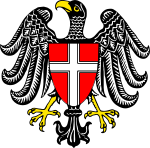
| |
| General Information | |
| Country: | Austria |
| State Capital: | Vienna |
| ISO 3166-2: | AT-9 |
| Vehicle Registration: | W |
| Community Identification Number: | 90101 - 92301 |
| Postal codes: | 1010 - 1239, 1400, 1450 |
| Area code: | 01 |
| Homepage: | www.wien.gv.at |
| State Flag of Vienna | |
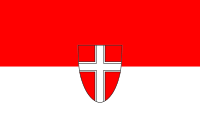
| |
| Map: Vienna in Austria | |
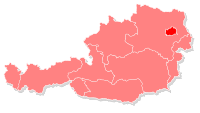
| |
| Name in other languages | |
| German | Wien |
| See "Vienna" in other languages | |
| Politics | |
| Mayor and governor | Michael Häupl (SPÖ) |
| Governing Party | SPÖ |
| Seats in the Municipal Council (100 seats): |
SPÖ 55 ÖVP 18 Greens 14 FPÖ 13 |
| Last Election: | 23 October 2005 |
| Next Election: | October 2010 |
| Population | |
| Population: | 1,660,534 (31.12.2005)[1] 2,165,357 metro area |
| Population density: | 4,002.2/km² |
| Geography | |
| Area: | 414.90 km² |
| - percent land: | 395.51 km² (95,33%) |
| - percent water: | 19.39 km² (4,67%) |
| Location: | 48°13′N 16°22′E |
| Dimensions: | North-South: 22.4 km East-West: 29.2 km |
| Highest Point: | 543 m (Hermannskogel) |
| Lowest Point: | 151 m (Lobau) |
| Administrative Structure | |
| Districts: | 1 Statutarstadt 23 Bezirke |
| Map: Districts of Vienna | |
| Bezirke of Vienna | |
Vienna (German: Wien [ʋiːn], Austro-Bavarian: Weăn, see also other names) is the capital of Austria, and also one of the nine States of Austria. Vienna is Austria's primate city; with a population of about 1.7 million (2.2 million within the metropolitan area), and is by far the largest city in Austria as well as its cultural, economic and political centre. Vienna lies in the very east of Austria and is close to the Czech Republic, Slovakia and Hungary. In 2001, the city centre was designated a UNESCO World Heritage Site[2] and the city ranks third in the world in terms of quality of life.[3]
History
Founded around 500 B.C.E., Vienna was originally a Celtic settlement. In 15 B.C.E., Vienna became a Roman frontier city ("Vindobona") guarding the Roman Empire against Germanic tribes to the north.
During the Middle Ages, Vienna was home of the Babenberg Dynasty and in 1440 became residence city of the Habsburg dynasties from where Vienna eventually grew to become the secret capital of the Holy Roman Empire and a cultural centre for arts and science, music and fine cuisine. The Ottoman invasions of Europe in the 16th and 17th centuries were stopped twice just outside Vienna (see Siege of Vienna, 1529 and Battle of Vienna, 1683).
In 1805, Vienna became capital of the Austrian Empire — and later the Austro-Hungarian Empire — and played a major role in European and World politics, including hosting the 1815 Congress of Vienna. Adolf Hitler lived in Vienna from 1907 until 1913. The Academy Of Fine Arts of the city rejected him as a student. When Hitler became broke and homeless he stayed at homeless shelters like the one on the Meldemann Strasse. In 1918, after World War I, Vienna became capital of the First Austrian Republic. In 1938 Hitler spoke to the Austrian people from the balcony of the Neue Burg, a part of the Hofburg at the Heldenplatz. Between 1938 (Anschluß) and the end of the Second World War, Vienna lost its status as a capital to Berlin. In 1945, the Vienna Offensive was successfully launched by the Soviets against the Germans holding Vienna. The city was besieged for about two weeks before it fell to the Soviets. After 1945, Vienna was again the capital of Austria. It was initially divided into four zones by the Allies. Vienna became a hot-bed for international espionage between the Western and Eastern blocs.
Historical population
Due to industrialization and immigration from other parts of the Empire, the population of Vienna increased sharply during its time as capital of Austria-Hungary (1867-1918). However, after World War I, many Czechs and Hungarians returned to their ancestral countries, resulting in a decline in the Viennese population. At the height of the immigration, about one third of the people living in Vienna were of Slavic or Hungarian descent.
By 2001, only 16% of people living in Vienna had nationalities other than Austrian, nearly half of which were from the former Yugoslavia; the next most numerous nationalities in Vienna were Turkish (39,000 or 2.5%), Polish (13,600 or 0.9%) and German (12,700 or 0.8%) [4].
Subdivision
Vienna is composed of 23 districts (Bezirke). Legally, they are not districts in the sense of administrative bodies with explicit powers (such as the districts in the other Austrian states), but mere subdivisions of the city administration. Elections at the district level give the representatives of the districts some political power in fields such as planning and traffic.
The 23 districts are numbered for convenience in a roughly clockwise fashion starting in the city centre: 1. Innere Stadt, 2. Leopoldstadt, 3. Landstraße, 4. Wieden, 5. Margareten, 6. Mariahilf, 7. Neubau, 8. Josefstadt, 9. Alsergrund, 10. Favoriten, 11. Simmering, 12. Meidling, 13.Hietzing, 14. Penzing, 15. Rudolfsheim-Fünfhaus, 16. Ottakring, 17. Hernals, 18. Währing, 19. Döbling, 20. Brigittenau, 21. Floridsdorf, 22. Donaustadt, 23. Liesing.
The heart and historical city of Vienna, the Innere Stadt, was once surrounded by walls and open fields in order to deny cover to potential attackers. The walls were razed in 1857, making it possible for the city to expand and eventually merge with the surrounding villages. In their place, a broad boulevard called the Ringstraße was built, along which imposing public and private buildings, monuments, and parks now lie. These buildings include the Rathaus (town hall), the Burgtheater, the University, the Parliament, the twin museums of natural history and fine art, and the Staatsoper. It is also the location of the Hofburg, the former imperial palace. The mainly Gothic Stephansdom is located at the centre of the city, on Stephansplatz. Beyond the Ringstraße, there was another wall called the Linienwall, which was torn down in the latter half of the 19th century to make room for expanding suburbs. It is now a ring road called Gürtel.
Industries are located mostly in the southern and eastern districts. The Innere Stadt is situated away from the main flow of the Danube, but is bounded by the Donaukanal ("Danube canal"). Vienna's second and twentieth districts are located between the Donaukanal and the Danube River. Across the Danube are the newest districts, which include the location of the Vienna International Centre.
Vienna's postal codes can be determined by the district where a given address is located; 1XXA - 1 denotes Vienna, XX the district number (if it is a single digit then with a leading zero), A is the number of the post office (irrelevant in this case, usually zero). Example: 1070 for Neubau. Exceptions include 1300 for the Vienna International Airport located in Lower Austria near Schwechat, 1400 for the UN Complex, 1450 for the Austria Center, and 1500 for the Austrian UN forces.
Politics
Until 1918, Viennese politics were shaped by the Christian Social Party, in particular long-term mayor Karl Lueger. Vienna is today considered the centre of Social Democracy in Austria. During the period of the First Republic (1918-1934), the Vienna Social Democrats undertook many overdue social reforms, improving the quality of life for hundreds of thousands of workers in the city. At that time, Vienna's municipal policy was admired by Socialists throughout Europe, who therefore referred to the city as "Red Vienna" (Rotes Wien). Since the end of the First World War, the city has been governed by the Social Democratic Party with absolute majorities in the city parliament. Only between 1934 and 1945, when the Social Democratic Party was illegal, mayors were appointed by the austro-fascist and later by the Nazi authorities. Current mayor of Vienna is Michael Häupl. The Social Democrats currently hold 55% of the seats with a 49% share of the vote[5]. An example of the city’s many social democratic policies is its low-cost residential estates called Gemeindebauten.
Ever since Vienna obtained federal state (Bundesland) status of its own in 1921, the mayor has also had the role of the state governor (Landeshauptmann). The Rathaus accommodates the offices of the mayor and the state government (Landesregierung). The city is administered by a multitude of departments (Magistratsabteilungen).
Religions
Vienna is the seat of the Viennese Roman Catholic archdiocese, and its acting Archbishop is Cardinal Christoph Schönborn. The religions of the Viennese resident population is divided according to the 2001 census as follows [4]:
| Roman Catholic | 49.2% |
| No religion | 25.7% |
| Muslim | 7.8% |
| Orthodox | 6.0% |
| Protestant (mostly Lutheran) | 4.7% |
| Jewish | 0.5% |
| Other or none indicated | 6.3% |
Culture
| Historic Centre of Vienna* | |
|---|---|
| UNESCO World Heritage Site | |
| State Party | |
| Type | Cultural |
| Criteria | ii, iv, vi |
| Reference | 1033 |
| Region** | Europe |
| Inscription history | |
| Inscription | 2001 (25th Session) |
| * Name as inscribed on World Heritage List. ** Region as classified by UNESCO. | |
Music, theatre and opera
- Translated from here
Art and culture have a long tradition in Vienna, including theatre, opera, classical music and fine arts. The Burgtheater is considered one of the best theatres in the German-speaking world alongside its branch, the Akademietheater. The Volkstheater Wien and the Theater in der Josefstadt also enjoy good reputations. There is also a multitude of smaller theatres, in many cases devoted to less mainstream forms of performing arts, such as modern, experimental plays or cabaret.
Vienna is also home to a number of opera houses, including the Staatsoper and the Volksoper, the latter being devoted to the typical Viennese operetta. Classical concerts are performed at well known venues such as the Wiener Musikverein, home of the Vienna Philharmonic Orchestra, and the Wiener Konzerthaus. Many concert venues offer concerts aimed at tourists, featuring popular highlights of Viennese music (particularly the works of Wolfgang Amadeus Mozart and Johann Strauss).
In recent years, the Theater an der Wien has become widely known for hosting premieres of musicals, although it has recently devoted itself to the opera again. The most successful musical by far was "Elisabeth", which was later translated into several other languages and performed all over the world. The Haus der Musik ("house of music") opened in 2000.
Many Roman Catholic churches in central Vienna also feature performances of religious or other music, including masses sung with classical music and organ.
Museums
- To be translated from here
The Hofburg is the location of the Schatzkammer (treasury), holding the imperial jewels of the Hapsburg dynasty. The Sisi Museum (a museum devoted to Empress Elisabeth Amalie Eugenie of Austria) allows visitors to view the Imperial apartments as well as the silver cabinet. Directly opposite the Hofburg are the Kunsthistorisches Museum and the Naturhistorisches Museum, which houses many paintings by old masters and ancient and classical artefacts.
A number of museums are located in the Museumsquartier (museum quarter), the former Imperial Stalls which were converted into a museum complex in the 1990s. It houses the Museum of Modern Art (Ludwig Foundation), the Leopold Museum (focussing on works of the Viennese Secession, Viennese Modernism and Austrian Expressionism), additional halls with feature exhibitions and the Tanzquartier. The Liechtenstein Palace contains one of the world's largest private art collections. There are a multitude of other museums in Vienna, including the Military History Museum, the Technical Museum, the Vienna Clock Museum and the Burial Museum. The museums dedicated to Vienna's districts provide a retrospective of the respective districts.
Architecture
- Translated from here
A variety of architectural styles can be found in Vienna, such as the Romanesque Ruprechtskirche and the Baroque Karlskirche. Styles range from classicist buildings to modern architecture. Art Nouveau left many architectural traces in Vienna. The Secession, Karlsplatz Stadtbahn Station, and the Kirche am Steinhof by Otto Wagner rank among the best known examples of Art Nouveau in the world.
The Hundertwasserhaus by Friedensreich Hundertwasser, designed to counter the clinical look of modern architecture, is one of Vienna's most popular tourist attractions. Another example of unique architecture is the Wotrubakirche by sculptor Fritz Wotruba.
In the 1990s, a number of quarters were adapted and extensive building projects were implemented in the areas around Donaustadt (north of the Danube) and Wienerberg (in southern Vienna). The 202 m-high Millennium Tower located at Handelskai is the highest building in Vienna[citation needed]. In recent years, Vienna has seen numerous architecture projects completed which combine modern architectural elements with old buildings, such as the remodelling and revitalisation of the old Gasometer in 2001.
Most buildings in Vienna are relatively low; there are currently (early 2006) around 100 buildings higher than 40 m. The number of high-rise buildings is kept low by building legislation aimed at preserving green areas and districts designated as world cultural heritage. Strong rules apply to the planning, authorisation and construction of high-rise buildings. Consequently, much of the inner city is a high-rise free zone.
Education
Vienna is also Austria's main centre of education and home to many universities, professional colleges and gymnasiums.
Universities
- Academy of Fine Arts Vienna
- Austrian Diplomatic Academy
- Medical University of Vienna
- PEF Private University of Management Vienna
- University of Applied Arts Vienna
- University of Natural Resources and Applied Life Sciences, Vienna
- University of Music and Performing Arts, Vienna
- University of Vienna
- University of Veterinary Medicine Vienna
- Vienna University of Economics and Business Administration
- Vienna University of Technology
- Webster University Vienna
- Internationales Kulturinstitut
International schools
- American International School Vienna
- Danube International School
- Vienna Christian School
- Vienna International School
- Lycée Francais de Vienne
Transportation
Twelve bridges cross the Danube in the city, which is divided by the Danube and its branch, the Neue Donau ("new Danube").
Public transportation
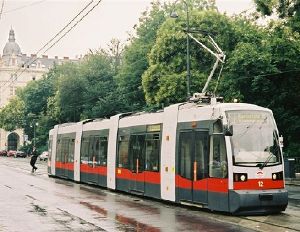
Vienna has a large public transportation network.
- Vienna S-Bahn
- Vienna U-Bahn
- Local Railways (Lokalbahn Wien-Baden)
- Wiener Linien (= Vienna Lines, municipal company operating U-Bahn, tram, and most bus routes)
Vienna has an extensive tram and bus network - the tram network being third largest in the world. In the most populated areas of Vienna, public transport runs so frequently (even during off-peak hours) that any familiarity with departure timetables is virtually unnecessary. The convenience and flexibility of the public transport is in turn reflected by its popularity; 53% of Viennese workers travel to their workplace by public transport.[6] During night hours, public transport is continued by the Nightline buses operating on all the main routes, generally every half hour.
Fare prices within the city are independent of the length of the journey and covers all modes of public transport. Tickets are also available for various time periods, such as 24 hour, monthly or yearly tickets.
The Viennese public transport services are incorporated into a larger concentric system of transport zones, the VOR (Verkehrsverbund Ostregion = eastern region traffic association). VOR includes railway and bus lines operating 50 kilometers into the surrounding areas, and ticket prices are calculated according to the number of zones.
Tickets must be purchased (and often stamped) prior to boarding or entering a station. Tickets are not checked when entering a station or boarding, there are however regular ticket inspections on all routes.
There are also two miniature railways: the Liliputbahn in the Wiener Prater and the Donauparkbahn in the Donaupark.
Railways
Historically, all transport was oriented towards the main cities in the Austro-Hungarian monarchy. Vienna has several train stations that form the beginning of several train lines:
- Wien Franz-Josefs-Bahnhof, the starting point of the Franz Josef Railway
- Wien Westbahnhof, starting point of the Western Railway
- Wien Südbahnhof (Former South and East Station) for the Southern Railway and the Eastern Railway
There are also several through train stations:
- Wien Hütteldorf on the Western Railway
- Wien Heiligenstadt on the Franz Josef Railway
- Wien Praterstern (Formerly known as Wien Nord or Wien Nord-Praterstern) on the Northern Railway.
- Wien Meidling (Philadelphiabrücke) on the Southern Railway. This is Vienna's most frequented transit station.
- Wien Mitte (Landstraße) on the S-Bahn Stammstrecke ("main line") is the nearest railway station to the centre of Vienna.
There are also a large number of smaller stations that are important for local passenger traffic. Since the mid 1990s, the Westbahnhof and Südbahnhof have handled all long-distance travel. Many trains also stop at Hütteldorf or Meidling, especially when inbound.
In order to bundle all long-distance traffic it has become necessary to build a tunnel, colloquially known as the Wildschweintunnel ("boar tunnel"), underneath Lainzer Tiergarten linking the Western Railway to the Southern Railway. The new bundled train line will connect to a new through train station called Wien Zentralbahnhof that will be constructed instead of the Südbahnhof.
Road traffic
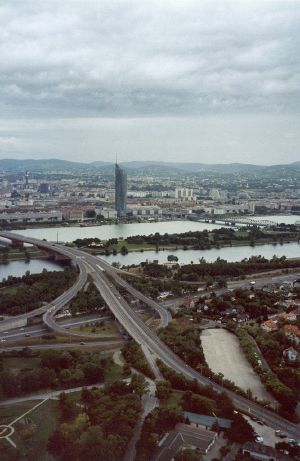
- To be translated from here
Similar to the train lines, Bundesstraßen leave the city in a star-shaped pattern. Some are named after their historical final destination (Prager Straße to Prague, Linzer Straße to Linz, Triester Straße to Trieste and Brünner Straße to Brno). Bundesstraßen can be compared to Federal Highways in the United States, being two-lane in rural areas and multi-lane in urban areas.
Three national autobahns leave Vienna in the westerly (A1), southerly (A2), and easterly directions (A4). Similar to the rail lines, they are commonly referred to after their exit direction (Westautobahn, Südautobahn, and Ostautobahn). In addition, several spur and branch autobahns circle around the southern and eastern areas of the city. The protected Wienerwald forest area in the western and northern areas has been left mostly untouched.
Air traffic
Vienna International Airport is located to the southeast of Vienna. The airport handled over 237,400 departures in 2006 and was frequented by 16.86 million passengers [7]. Following lengthy negotiations with surrounding communities, the airport will be expanded to increase its capacity by adding of a third runway. The airport is currently undergoing a major enlargement (construction of several new buildings) to prepare for an expected increase in passengers.
Water transportation
- To be translated from here
Vienna is connected to Rotterdam and German Industrial areas via the Rhine-Main-Danube Canal, and to Eastern European countries along the Danube to the Black Sea. The planned Danube-Oder canal remains unfinished.
The "Twin City Liner" boat service connects Vienna and Bratislava.
Nearly all of Vienna's drinking water is brought to the city via two large water pipelines, built in the late 19th and early 20th centuries. The pipelines stretch 120 km (75 miles) and 200 km (124 miles) from the Alps to the city's Hietzing district. The Alpine sources are pristine and the water does not require treatment.
Leisure activities
Viennese parks and gardens
Vienna possesses many park facilities and is one of the greenest cities in the world. Parks include the Stadtpark, the Burggarten, the Volksgarten (part of the Hofburg), the Schloßpark at Schloss Belvedere (home to the Vienna Botanic Gardens), the Donaupark, the Schönbrunner Schlosspark, the Prater, the Augarten, the Rathauspark, the Lainzer Tiergarten, the Dehnepark, the Resselpark, the Votivpark, the Kurpark Oberlaa, the Auer-Welsbach-Park and the Türkenschanzpark. Green areas include Laaer-Berg (including the Bohemian Prater) and the foothills of the Wienerwald, which reaches into the outer areas of the city. Small parks, known by the Viennese as Beserlparks, are everywhere in the inner city areas. Many of Vienna's famous parks include monuments, such as the Stadtpark with its statue of Johann Strauss II, and the gardens of the baroque palace, where the State Treaty was signed. Vienna's principal park is the Prater which is home to the Riesenrad, a ferris wheel. The imperial Schönbrunn's grounds contain an 18th century park which includes the world's oldest zoo, founded in 1752. The Donauinsel, part of Vienna's flood defences, is a 21.1 km long artificial island between the Danube and Neue Donau dedicated to leisure activities.
Sport
Vienna hosts many different sporting events including the Vienna City Marathon, which attracts more than 10,000 participants every year and normally takes place in May. In 2005 the Ice Hockey World Championships took place in Austria and the final was played in Vienna. Vienna's Ernst Happel Stadium was the venue of four Champions League and European Champion Clubs' Cup finals (1964, 1987, 1990, 1995) and will host the final of Euro 2008.
Austria's capital is home to numerous teams. The best known are the local football clubs SK Rapid Wien (31 Austrian Bundesliga titles), FK Austria Wien (23 Austrian Bundesliga titles and 26-time cup winners) and the oldest team, First Vienna FC. Other important sport clubs include the Chrysler Vikings Vienna (American Football), who won the Eurobowl title in 2004, the Vienna Hot Volleys, one of Europe's premier Volleyball organisations, and the Vienna Capitals (Ice Hockey).
Culinary specialities
Food
Vienna is well known for Wiener schnitzel, a cutlet of veal that is pounded flat, coated in flour, egg and breadcrumbs, and fried in clarified butter. It is available in almost every restaurant that serves Viennese cuisine. Other examples of Viennese cuisine include "Tafelspitz" (very lean boiled beef), which is traditionally served with "Gerösteten Erdäpfeln" (boiled potatoes mashed with a fork and subsequently fried) and horseradish sauce, "Apfelkren" (a mixture of horseradish, cream and apple) and "Schnittlauchsauce" (a chives sauce made with mayonnaise and old bread).
Vienna has a long tradition of cakes and desserts. These include Apfelstrudel (hot apple strudel), Palatschinken (sweet pancakes), and Knödel (dumplings) often filled with fruit such as apricots (Marillenknödel). Sachertorte, a dry chocolate cake with apricot jam from the Sacher Hotel, is world famous.
In winter, small street stands sell traditional Maroni (hot chestnuts) and potato fritters. Sausages are also popular and available from street vendors throughout the night. The sausage known as Wiener (German for "Viennese") in the USA and Germany is however called a Frankfurter. Other popular sausages are Burenwurst (a coarse beef and pork sausage, generally boiled) and Käsekrainer (spicy pork with small chunks of cheese).
The Naschmarkt is a permanent market for fruit, vegetables, spices, fish, meat and much more from around the world. The city centre has many speciality food stores, such as the "Julius Meinl am Graben".
Drink
Vienna is the world's only capital city with its own vineyards (although Paris also retains a single vineyard, and Prague has some also). The wine is served in small Viennese pubs known as Heuriger, which are especially numerous in the wine growing areas of Döbling (Grinzing, Neustift am Walde, Nußdorf, Salmannsdorf, Sievering) and Floridsdorf (Stammersdorf, Strebersdorf). The wine is often drunk as a spritzer ("G'spritzter") with sparkling water. The Grüner Veltliner, a white wine, is the most widely cultivated wine in Austria.
Beer is next in importance to wine. Vienna has a single large brewery, Ottakringer, and more than ten microbreweries. A "Beisl" is a typical small Austrian pub, of which Vienna has many.
Viennese cafés
Viennese cafés have an extremely long and distinguished history that dates back centuries, and the caffeine addictions of some famous historical patrons of the oldest are something of a local legend. Traditionally, the coffee comes with a glass of water. Viennese cafés claim to have invented the process of filtering coffee from bounty captured after the second Turkish siege in 1683. Viennese cafés claim that when the invading Turks left Vienna, they abandoned hundreds of sacks of coffee beans. The Emperor gave Franz George Kolschitzky some of this coffee as a reward for providing information that allowed the Austrians to defeat the Turks. Kolschitzky then opened Vienna's first coffee shop. Julius Meinl set up a modern roasting plant in the same premises where the coffee sacks were found, in 1891.
Tourist attractions
Major tourist attractions include the imperial palaces of the Hofburg and Schönbrunn (also home to the world's oldest zoo, Tiergarten Schönbrunn) and the Riesenrad in the Prater. Cultural highlights include the Burgtheater, the Wiener Staatsoper, the Lipizzaner horses at the spanische Hofreitschule and the Vienna Boys' Choir, as well as excursions to Vienna's Heuriger districts.
There are also more than 100 art museums, which together attract over eight million visitors per year [1]. The most popular ones are Albertina, Belvedere, Leopold Museum in the Museumsquartier, KunstHausWien, BA-CA Kunstforum, the twin Kunsthistorisches Museum and Naturhistorisches Museum, and the Technisches Museum Wien, each of which receives over a quarter of a million visitors per year [8].
There are many popular sites associated with composers who lived in Vienna including Beethoven's various residences and grave at Zentralfriedhof (Central Cemetery) which is the largest cemetery in Vienna and the burial site of many famous people. Mozart has a memorial grave at the Hapsburg gardens and at St. Marx cemetery (where his grave was lost). Vienna's many churches also draw large crowds, the most famous of which are St. Stephen's Cathedral, the Deutschordenskirche, the Jesuitenkirche, the Karlskirche, the Peterskirche, Maria am Gestade, the Minoritenkirche, the Ruprechtskirche, the Schottenkirche and the Votivkirche.
Modern attractions include the Hundertwasserhaus, the United Nations headquarters and the view from the Donauturm.
- Vena 19.jpg
Hundertwasserhaus
- Albertina Wien001.jpg
Albertina
- Secession Vienna June 2006 006.jpg
The Secession building
The Gloriette at Schönbrunn
International organizations in Vienna
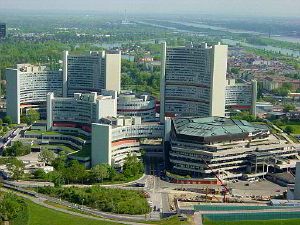
Vienna is the seat of a number of United Nations offices and various international institutions and companies, including the United Nations Industrial Development Organization (UNIDO), the Organization of Petroleum Exporting Countries (OPEC), the International Atomic Energy Agency (IAEA), the Preparatory Commission for the Comprehensive Nuclear-Test-Ban Treaty Organization (CTBTO) and the Organization for Security and Co-operation in Europe (OSCE). Furthermore, the 1980 Diplomatic Conference was held in Vienna that led to the adoption of the United Nations Convention of Contracts for the International Sale of Goods. Additionally, Vienna is the seat of the United Nations Commission on International Trade Law's secretariat (UNCITRAL).
Charitable organizations in Vienna
Alongside the international and intergovernmental organisations, there are dozens of charitable organisations based in Vienna; these organisations provide relief goods and assistance to tens of thousands of disadvantaged children and needy people in developing countries.
One such organisation is the network of SOS Children's Villages, founded by Hermann Gmeiner in 1949. Today, SOS Children's Villages are active in 132 countries and territories worldwide. Others include HASCO and the Childrens Bridge of Hope.
Notable Residents
Names in italic text born in Vienna.
Twin cities
Vienna is twinned with the following cities:
Other forms of cooperation and city friendship similar to the twin city programmes:
|
In addition, individual Viennese districts are twinned with Japanese cities/districts:
- Alsergrund with Takarazuka, Hyogo. Since 1994.
- Döbling with Setagaya, Tokyo. Since 1985.
- Donaustadt with Arakawa, Tokyo. Since 1996.
- Floridsdorf with Katsushika, Tokyo. Since 1987
- Hernals with Fuchu, Tokyo. Since 1992.
- Hietzing with Habikino, Osaka. Since 1995.
- Innere Stadt with Taito, Tokyo. Since 1989.
- Meidling with Gifu, Gifu. Since 1992.
See also
- Vienna International Airport
- Vienna Circle
- List of mayors of Vienna
- List of Viennese
- List of Honorary Citizens of Vienna
- Viennese German
- Donauinsel
- Donauinselfest
ReferencesISBN links support NWE through referral fees
- ↑ 1.0 1.1 Übersicht Bevölkerungsstatistik (in German) (PDF). City of Vienna. Cite error: Invalid
<ref>tag; name "population" defined multiple times with different content - ↑ Historic Centre of Vienna. UNESCO.
- ↑ Vancouver is 'best place to live'. BBC (October 4, 2005).
- ↑ 4.0 4.1 (2003) Volkszählung. Hauptergebnisse I - Wien (PDF) (in German), Statistik Austria.
- ↑ Gemeinderatswahl 2005. wien.at. (German)
- ↑ Der Standard, Tuesday 27th March 2007
- ↑ Vienna International Airport (2007-01-18). Sound traffic development in 2006. Press release. Retrieved on 2007-02-07.
- ↑ Top 30 Sights, Museums, Exhibition Halls 2005 (xls). Vienna Tourist Board.
External links
- Wien.info - Official site of the tourism board: events, sightseeing and cultural information, etc.
- Wien.gv.at - Official site of the municipality, features interactive map.
- Travel guide to Vienna, Austria from Wikitravel
- Interactive online city tours through Vienna Lots of information and picture, has maps as well
- List of Embassies in Vienna
- PhotoGlobe Vienna - Geo-referenced photos of Vienna together with small maps and satellite images
- Vienna Tourism Tourist attractions in Vienna, with descriptions and maps
Template:States of Austria
Template:Districts of Vienna
Countries: Germany · Austria · Slovakia · Hungary · Croatia · Serbia · Romania · Bulgaria · Ukraine · Moldova
Cities: Donaueschingen · Ulm · Ingolstadt · Regensburg · Passau · Linz · Vienna · Bratislava · Győr · Esztergom · Budapest · Baja · Vukovar · Ilok · Bačka Palanka · Novi Sad · Belgrade · Smederevo · Drobeta-Turnu Severin · Vidin · Rousse · Brăila · Galaţi · Tulcea
Tributaries (list): Iller · Lech · Regen · Isar · Inn · Morava · Drava · Tisza · Sava · Timiş · Velika Morava · Jiu · Iskar · Olt · Osam · Yantra · Vedea · Argeş · Ialomiţa · Siret · Prut
af:Wene als:Wien am:ቪየና ar:فيينا an:Biena arc:ܒܝܢܐ frp:Vièna (Ôtrich·e) az:Vyana be:Горад Вена be-x-old:Вена bar:Wean bs:Beč br:Vienna bg:Виена ca:Viena ceb:Vienna cs:Vídeň cy:Wien da:Wien de:Wien et:Viin el:Βιέννη es:Viena eo:Vieno eu:Viena fr:Vienne (Autriche) fur:Viene ga:Vín gd:Vienna gl:Viena - Wien ko:빈 hy:Վիենա hr:Beč io:Wien id:Wina is:Vín (Austurríki) it:Vienna he:וינה ka:ვენა kw:Wien sw:Vienna la:Vindobona lv:Vīne lb:Wien lt:Viena li:Wene lmo:Vièna hu:Bécs mk:Виена mr:व्हियेना mn:Вена nl:Wenen nds-nl:Wienen ja:ウィーン no:Wien nn:Wien nov:Wien oc:Viena (Àustria) nds:Wien (Stadt) pl:Wiedeń pt:Viena ro:Viena rmy:Bech qu:Wien ru:Вена sq:Vjena simple:Vienna sk:Viedeň sl:Dunaj sr:Беч sh:Beč fi:Wien sv:Wien ta:வியன்னா th:เวียนนา vi:Wien tg:Вена (шаҳр) tr:Viyana uk:Відень vec:Viena vo:Wien bat-smg:Viena zh:維也納
Credits
New World Encyclopedia writers and editors rewrote and completed the Wikipedia article in accordance with New World Encyclopedia standards. This article abides by terms of the Creative Commons CC-by-sa 3.0 License (CC-by-sa), which may be used and disseminated with proper attribution. Credit is due under the terms of this license that can reference both the New World Encyclopedia contributors and the selfless volunteer contributors of the Wikimedia Foundation. To cite this article click here for a list of acceptable citing formats.The history of earlier contributions by wikipedians is accessible to researchers here:
The history of this article since it was imported to New World Encyclopedia:
Note: Some restrictions may apply to use of individual images which are separately licensed.

